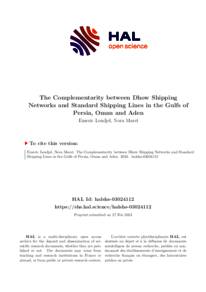Document
The complementarity between dhow shipping networks and standard shipping lines in the Gulfs of Persia, Oman and Aden.
Identifier
DOI: 10.4000/cybergeo.37025
Source
CyberGeo. v. 2021
Contributors
Marei, Nora., Author
Other titles
[La complémentarité entre le réseau de boutres et celui des transports maritimes standardisés dans les golfes Persique, d’Oman et d’Aden]
[La complementariedad entre la red de dhows y el transporte marítimo en el Golfo Pérsico de Omán y Adén]
Country
France
Publisher
Geographie-Cites.
Gregorian
2021-01-01
Language
English
English abstract
This article provides the very first appraisal of the extent of dhow shipping networks and their transport capacity around the Arabian Peninsula (in the Persian Gulf and the Arabian Sea) and the level of interconnection between dhow and containerized shipping. Dhows have a characteristic ogival-shaped wooden hull and a decorated superstructure at the stern. With a modest transport capacity ranging from 200 tons to more than 2,000 tons for the largest, dhows stay below the radars of academic research. Yet, compiled satellite pictures using Google-Earth allow a census to be conducted of dhows along coastlines and to measure their transport capacity and the extent of their network. The article starts with a short survey of the existing literature, and then presents the methodological framework of the study. It tests the spatial complementarity/duality of dhow networks with normal maritime networks (i.e. mainly containerized shipping lines), so as to understand the economic conditions of dhows’ survival. Next, it shows that the embeddedness of dhow ports in cities is also part of the explanation of surviving dhow trade. A concluding discussion tackles the necessity of normalization interfaces when a standardized transport network is interconnected with a local traditional transport network in a port.
ISSN
1278-3366
Resource URL
Category
Journal articles

